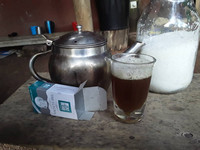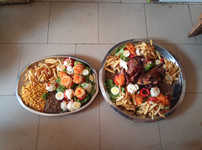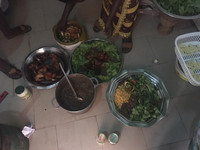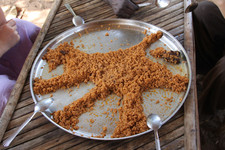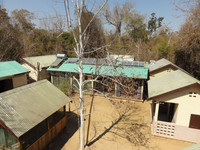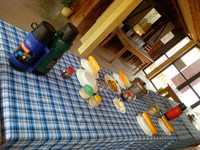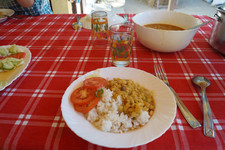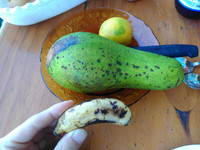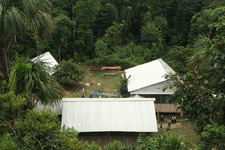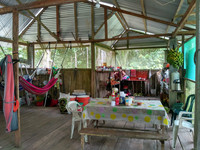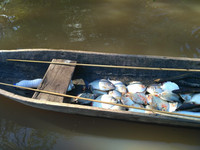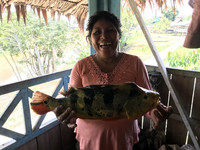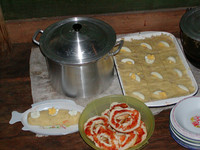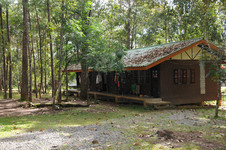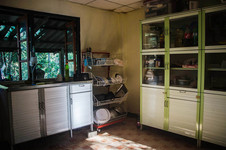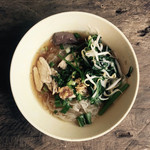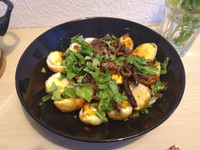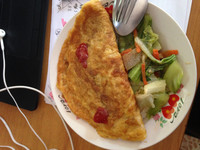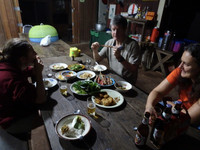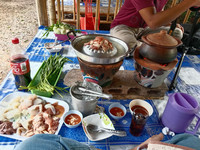Dining in the wild
Peru, Senegal, Northern Guinea, Madagascar, Thailand: The DPZ operates five field stations on three continents. Here you learn all about the food on the other side of the world. Work at the field stations is exhausting, which is why meals play a major role in the researchers' everyday lives. Good food maintains motivation and health, and meals eaten together promote group cohesion. But which dishes are served in the different countries? And who is in charge of cooking and taking care of the supplies?
Senegal
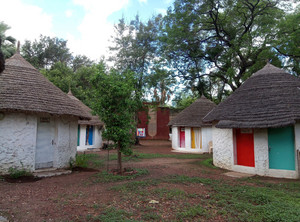
The Centre de Recherche de Primatologie Simenti is located in the largest national park of West Africa, the Niokolo Koba National Park. Here, researchers investigate ecology and behaviour of Guinea baboons. As Sementi is also a military base of the national park, the researchers and field assistants live together with three rangers at the station. For lunch and dinner, specially hired cooks provide researchers and rangers with freshly cooked meals, while everyone is in charge of preparing their own breakfast. Food, including private snacks, is bought once a month in the nearest town.
Breakfast in Simenti usually consists of muesli or freshly baked bread with sweet spreads, and coffee or tea, while for the rest of the day more traditional Senegalese meals are served. For lunch, dishes such as Thieboudienne (Senegal's national dish consisting of rice with fish and vegetables), Yassa (rice with fish and onion sauce) or Mafé (rice with peanut sauce, beef and vegetables) are the order of the day. "Another traditional dish, Thiou diw tiir, which consists of rice with palm oil sauce and fish, was so unpopular with the researchers that it has since been banned," says Irene Gutiérrez Díez, camp manager of Simenti. After lunch, Ataya tea is served - a traditional green tea which is first frothed by repeatedly pouring it back and forth and then is drunk with lots of sugar. Dinner is more varied than lunch and takes place in front of a TV to watch the news or football matches. There is pasta, fries or couscous in combination with various sauces, pulses, salads and meats. Meals tend to be single-dish affairs in Senegal and thus, everyone is usually eating from the same big bowl or pot. Water comes from a well and gets filtered before drinking.
During the monthly trips to the city, the researchers not only stock up on supplies, but also use their freetime to indulge their culinary desires. "On these days, we can't avoid eating our fill of pizzas and salads," says Irene Gutiérrez Díez, "and now there are even shops selling French pastries and ice cream. What a dream!"
Madagascar
The DPZ field station Kirindy Forest is located in Western Madagascar, one of the most important biodiversity hotspots in the world. Here, the main focus of research is on lemurs, which only occur on the island state.
In Kirindy, two cooks prepare fresh meals for the researchers and eight local field assistants. Food is purchased once a week in the coastal town Morondava, which is why fresh fruit and vegetables may become scarce towards the end of the week. As there is no well at the field station, every week large water canisters have to be filled up at the well of the neighbouring village Beroboka via off-road vehicles and are brought back to the station. Before drinking, the water then needs to be filtered.
For breakfast everyone gets a piece of baguette, some omelette, butter, a small banana and jam (sometimes made from local fruits like Jujube). In addition, there is a thick rice soup (Vary sosoa), which can be eaten hearty with some herbs and omelette or meat, or sweet with cinnamon, banana and sweetened condensed milk (Ronono). For lunch, there is always rice with different kinds of beans or lentils, together with meat (mostly poultry or zebu - the local domestic cattle) and fresh salad. "When we're not fighting about who gets to finish the salad, we often discuss over lunch our preferences in the different types of beans and lentils," jokes Johanna Henke - from Malsburg, PhD student in the department of "Behavioural Ecology and Sociobiology". Fruit are most often eaten for dessert after lunch, yet occasionally the cooks prepare Crêpes or Banana flambée. Dinner is the most variable meal of the day. For example, there can be pasta with tomato sauce, Minsao (a fried pasta dish with vegetables and egg), French fries with sauteed vegetables or even sometimes pizza topped with carrots, peppers and green beans. The Malagasy staff prefer a more meat-heavy diet and therefore usually enjoy rice with meat in various sauces for dinner. Sakay, a traditional extremely spicy dip made from dried chillies, can be found on each dinner table in Madagascar and is used to add some pep to the meals.
The researchers spend every second weekend in Morondava, where they can cook for themselves or enjoy the luxury of Beignets de Crevette (shrimps in batter), freshly caught fish, Sambos (fried dumplings filled with meat, fish or vegetables), Mousse au Chocolat, ice cream and cola in the cities’ restaurants. Here, they also stock up on snacks for the forest, such as chocolate, biscuits and crackers.
Peru
The Peruvian Estación Biológica Quebrada Blanco (EBQB) is located on the world's most water-rich river, the Amazon. The tropical rainforests are home to many new world monkeys - the study subjects of the researchers.
Due to the very remote location of the field station (it takes 24 hours on foot and by boat to the next bigger city, Iquitos) the team, consisting of researchers and 2-3 local field assistants, restocks food only once a month. Thus, the fresh food is used up within the first week and a half and only longer-lasting foods remain, such as canned food, rice or pasta. However, fresh fish and fruit (such as pineapple, watermelon, Ungurahui (a local palm fruit), bananas or passion fruit) can occasionally be acquired from local fishermen or neighbouring villagers. "In camp, we have also planted bushes with chillies and coconas. Coconas are tomato-like, sour fruit that make a delicious lemonade," says Eckhard Heymann, head of the field station. Water comes directly from a small nearby stream and is so clean that the researchers can drink it unfiltered. Whether a cook is hired for a field season depends on the number of people that stay in the station.
Usually researchers start the day with oatmeal or homemade bread, like the traditional Roscas - ring-shaped rolls that resemble rusks - with butter and jam. The local field assistants like to have Avena for breakfast - a hot drink made from milk, water, oatmeal, cinnamon and sugar. Lunch and dinner consist of rice, noodles or cooked/roasted plantains or yuca (manioc) combined with beans, lentils or peas. If still available, vegetables (e.g. cucumbers, tomatoes, beetroot, onions, cabbage) are served as salad, stewed or fried, and sauces, for example made from ketchup and mushrooms. "To make the food more interesting, we also like to use canned cheese. It tastes disgusting when eaten fresh, but makes a very tasty cheese sauce," says Omer Nevo, a former PhD student in the Department of “Behavioural Ecology and Sociobiology”. At the EBQB, food is mainly vegetarian, but every now and then fresh fish, poultry or meat is served. Salchichas (cheap canned sausages) are particularly popular. In addition to fruit, researchers also enjoy homemade popcorn, hot chocolate and crackers for snacks. On days off in Iquitos, they like to storm local ice cream parlours or treat themselves to pizza.
Thailand
The Phu Khieo Wildlife Sanctuary (PKWS) research station is located in north-eastern Thailand and is part of the Western Isaan Forest Complex, a large forested area on the border to Laos. Here, researchers study the social behaviour of Assamese macaques.
In Thailand, cooks provide the team with lunch and dinner, while everyone is in charge of their own breakfast. The car drive to the next town with bigger supermarkets, to stock up on food, takes about two hours. Water comes from a nearby lake and is piped directly to the camp where it is filtered for drinking.
In Thailand, researchers and six local field assistants work in a shift system, either in the morning or in the afternoon. That is why individual mealtimes can differ a lot. Only dinner is eaten together. "In Thailand, you can get almost everything you know from your home country in the supermarkets," explains Niels Kil, PhD student in the research group "Social Evolution of Primates". "So, most of us start the day with cornflakes, muesli or sweet toast and fruit". For lunch, the cooks usually prepare a curry or omelette with rice and various vegetables. In the evening there is always rice, served with a variety of different side dishes, which change on a daily basis. Common traditional side dishes include: Som Tam (a spicy green papaya salad), Khai Luk Koei ("son-in-law eggs", fried, boiled eggs with tamarind sauce), Tom Gha Kai (chicken soup with coconut milk and galangal) or Pad Thai (rice noodles with fish sauce, tamarind paste, eggs, fish/meat/tofu, peanuts and herbs). Occasionally, they have a kind of BBQ with a Mu kratha (a mix between BBQ grill and hotpot), where different ingredients (meat, fish, vegetables, tofu, noodles) are grilled or cooked in a broth and eaten with different dips. "We don’t have desserts that often, but one of everyone’s favorite dessert is definitly Kao Niew Ma Mung, sweet sticky rice with mango", laughs Nils Kil. Common snacks at the field station are fruit (such as Nashi pears, tamarinds, lychees, or pineapples), crackers and biscuits. On days off in the city researchers often treat themselves to tasty desserts (such as ice creams, crêpes, brownies), smoothies or pizza.

